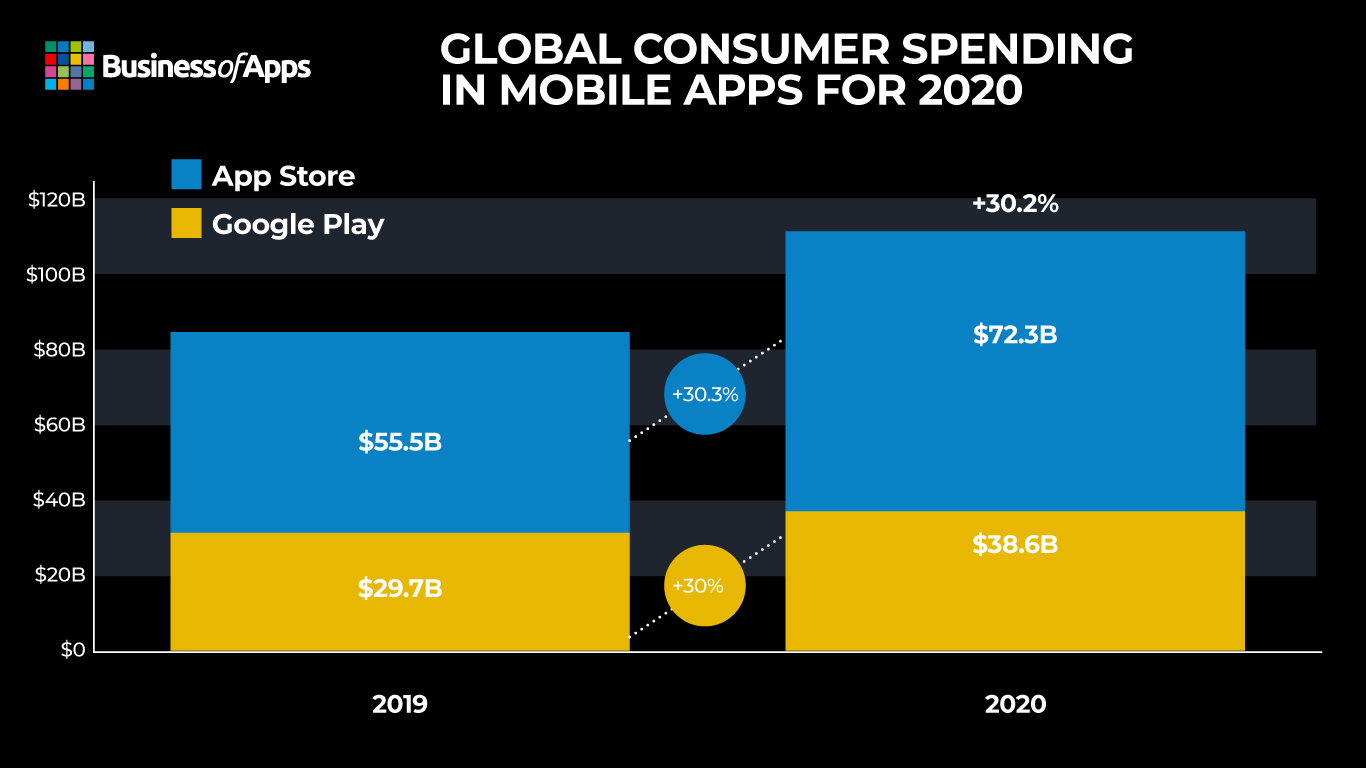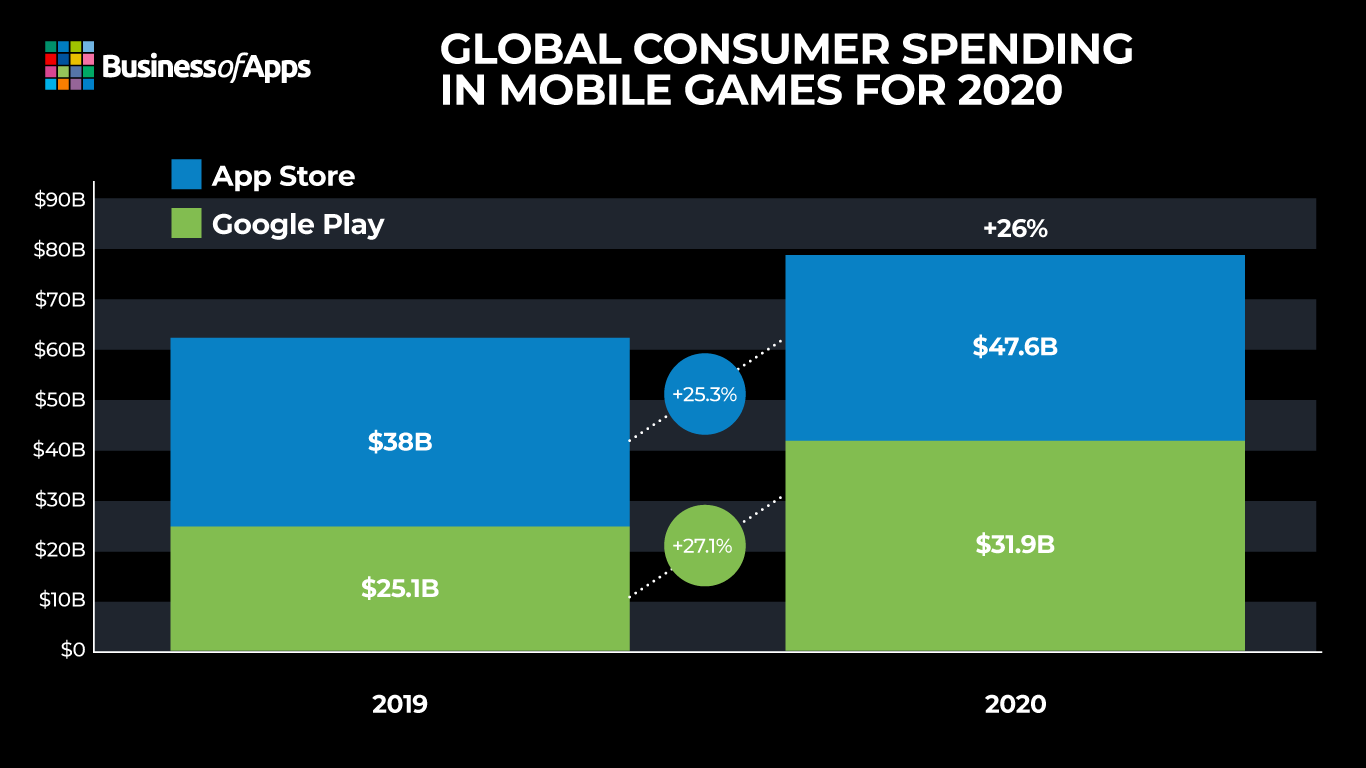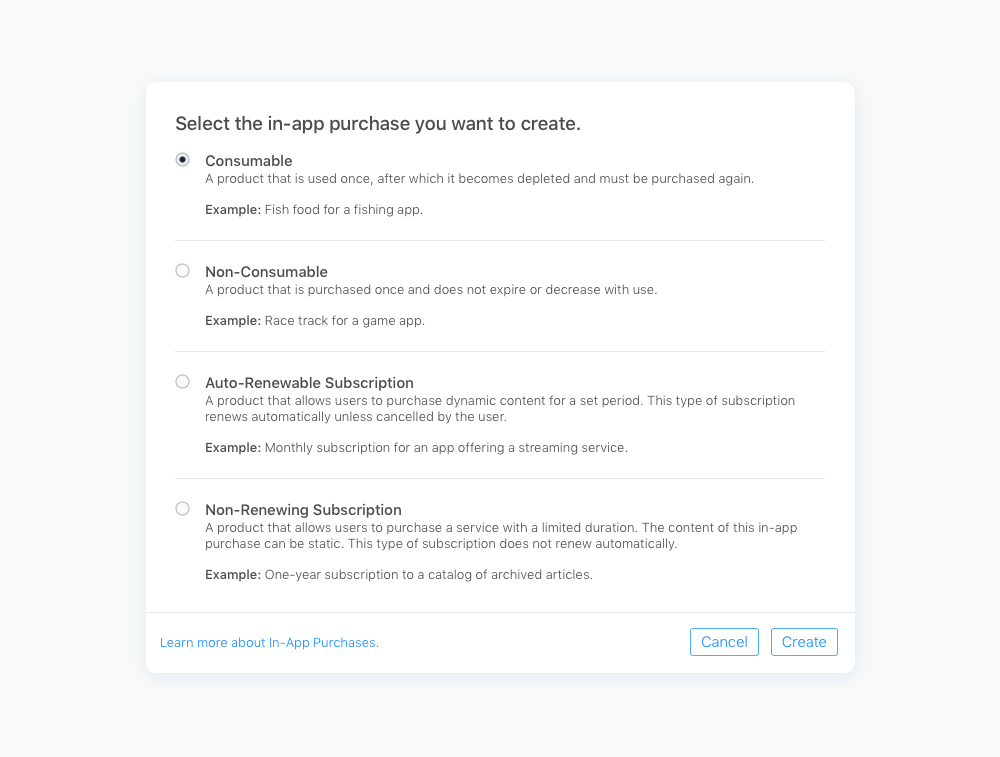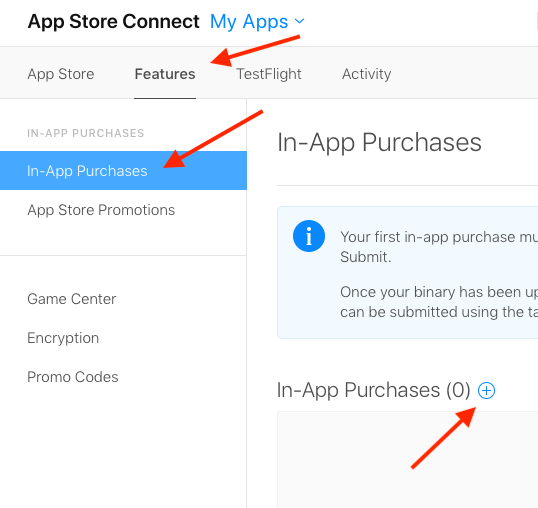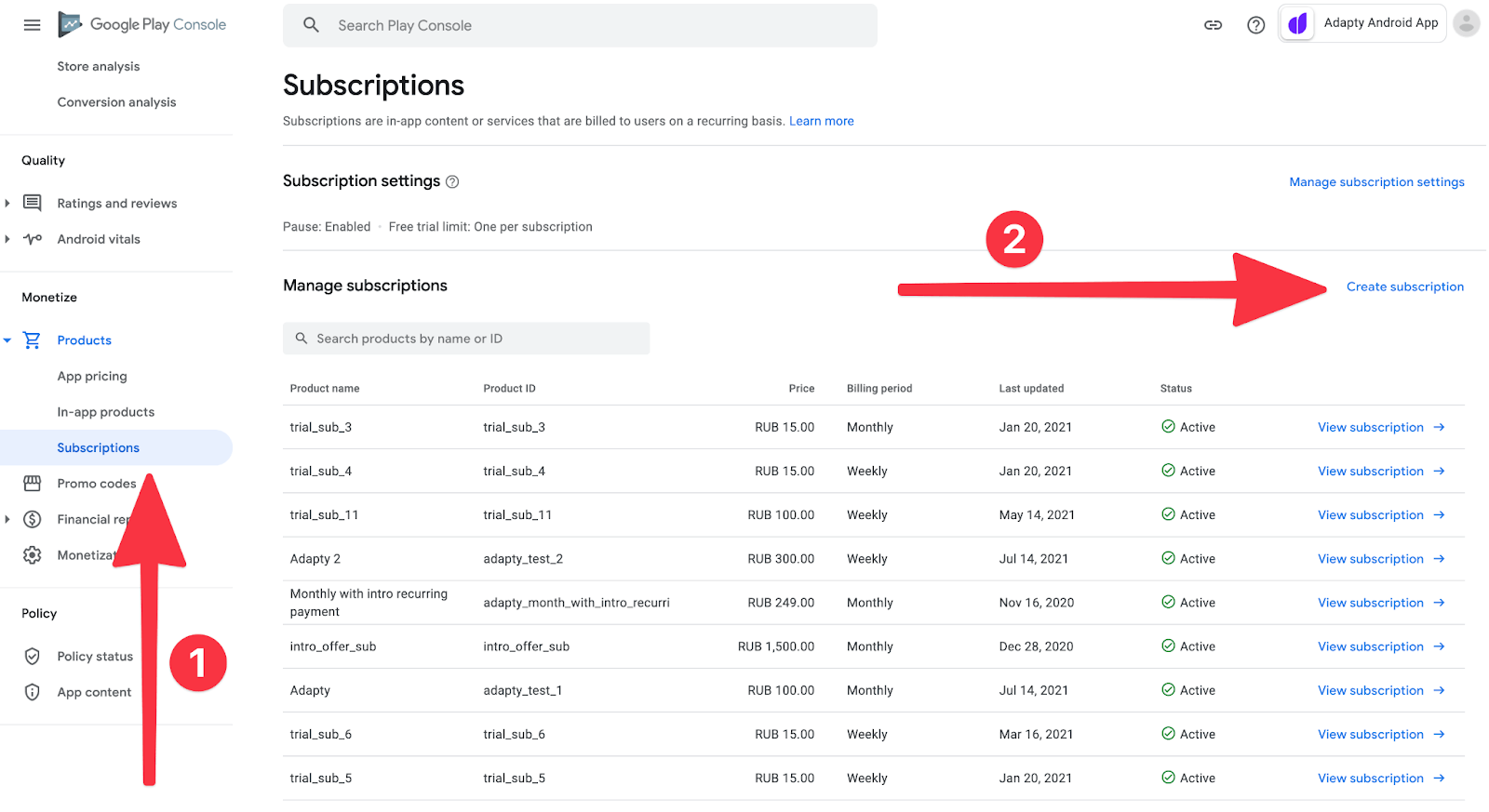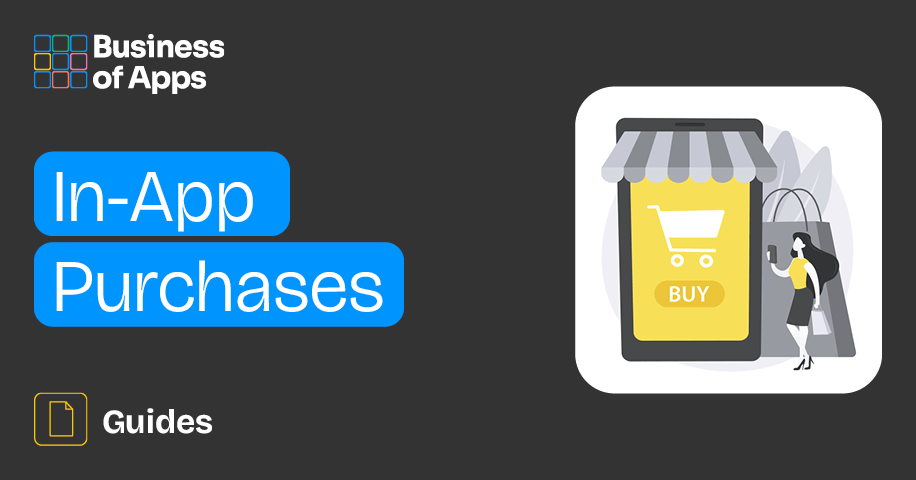
Mobile app monetization is one of the most important factors to consider when developing an app. After all, the ultimate goal for any marketer or developer is to generate revenue from their app, right?! They need to cover the costs of both developing and marketing it, and they also have to make a neat profit for themselves as well. So far so good. But then, how does one go about achieving just that?
Well, there are certainly many ways to skin a cat… to monetize an app, I mean. We have already explored one such way in our guide to in-app subscriptions, where we talk about the ins and outs of in-app subscriptions, their benefits and challenges, and how to implement and manage them. So, go check that guide one first if you haven’t already. Today, we are turning to the other major way of monetizing an app, namely in-app purchases.
As always, we will start with a definition of the concept before proceeding to explore the benefits and challenges of implementing in-app purchases. We will then talk about how to implement and manage them before giving you our best practices to make sure you ace in-app purchases.
Understand user expectations and privacy trends to monetize efficiently
Discover how 4,000 users view ads and data sharing, explore new tactics to boost ad revenue and retention, and learn from industry leaders how top apps turn privacy shifts into profit.
Find out moreWe also have plenty of data, graphs, examples, and playful language (it’s the author’s trademark, and he would refuse to write if not allowed to play on words) for you to take in, so let’s get started.
Key in-app purchases statistics
- The prediction for the overall mobile app market is for continuous growth. The market is expected to reach a staggering $2.5 trillion in revenue in 2024.
- Google Play generated $21.5 billion and the Apple App Store generated $24.6 billion in sales in Q1 2024.
- 98% of Google Play revenue comes from free apps.
- In-app purchases are one of the most common monetization models. An estimated 50% of non-game and 79% of game apps use it.
- In-app purchases account for 48.2% of mobile app earnings as compared to 14% from ads-based revenue and 37.8% from paid app downloads.
- Users are spending $380 billion worldwide on in-app purchases.
App Revenue Buyer's Guide
Download the App Revenue Buyer’s Guide today and start shaping the future of your app! Your journey towards app monetization mastery begins now.
What are in-app purchases?
However, once an in-app purchase is made, the user generally (we will get to that in a second… or however fast you read) retains access to whatever they have purchased for as long as they keep using the app, independent of whether they have a freemium or premium account. As such, in-app subscriptions are a type of in-app purchase.
In-app purchases are implemented on all major mobile platforms, including iOS, Android, and Windows Phone.
Benefits and challenges of in-app purchases
Now that we have a working definition of the concept, let’s consider some of the major benefits of IAPs and the biggest challenges involved in implementing and managing them.
Stable source of revenue
We’ve already said it, but there’s no harm in repeating important stuff: in-app purchases are a great monetization model for mobile apps. Monetizing an app through in-app purchases is a reliable way to guarantee yourself a steady source of revenue, giving you the financial freedom and security to experiment with new ideas and features for your app. In-app purchases are one of the best ways, if not the best, to get money for all your hard work developing and launching a new app. But that’s just scratching the surface, so let’s dive deeper.
Freemium or premium, that is the question
One of the most lucrative reasons to implement in-app purchases is that you can keep your app’s core features free and accessible to all users. Subscription apps have a huge acquisition problem and that is the subscription fees themselves and finding users willing to pay them. Additionally, deciding whether you are going to offer a free version of the app and/or a free trial period and then finding the right balance between what’s going to be free and what’s going to be premium further complicates matters… and UA for subscription apps.
Successful implementation of in-app purchases for your app means that you are free of this problem as you can keep the key aspects of your app… well, free for all, which, in turn, will attract more users. An app monetized through in-app purchases feels like it’s offering its users the full app experience no matter whether they commit to any purchases or not. Purchases then feel like individual upgrades à la carte, and users can decide for themselves whether they want them or not, allowing them to customize their app experience to their heart’s content without feeling like they are being forced to pay a monthly fee to access functionalities that they might not need or want in their entirety. Put simply, in-app purchases give users more liberty in deciding how to experience your app.
This is certainly not true of subscription apps, where the premium version often feels like the “true” app, while the freemium is there to just attract users and encourage them to subscribe. As a result, people who don’t want or can’t afford to pay the subscription fees might eventually churn, i.e. drop out.
What is more, in-app purchasing is presently dominating the mobile app market. Consider the following: the revenue that is generated by consumers making in-app purchases is 20 times greater than the revenue created by subscription apps for about 48% of mobile app earnings. With such a massive headway, marketers for apps that implement in-app purchases have got to be doing something right, of course. But the simple ease of attracting large user bases to an ostensibly free app and then offering them individual take-it-or-leave-it paid upgrades cannot be understated.
But as always, there are many caveats. Many apps implement both subscriptions and purchases, others prefer to implement only one of these monetization models or opt for a different monetization strategy altogether.
Mobile games are a great example. Most mobile games don’t offer subscriptions and offer the game as free-to-play to all, meaning the core experience is there to be experienced by anyone interested. Instead, mobile game apps generate most of their income through in-app purchases that allow users to customize their app experience without altering the core gameplay. Think skins or special passes with access to gated content for example. Players get something tangible in return for their money, while the ones not willing or able to play are not disadvantaged gameplay-wise if they don’t commit.
But as we have said before, there are many ways to skin a cat and this is just one example. The trick to successfully monetizing an app is finding the perfect balance between subscriptions, in-app purchases, and ads. Different types of apps need different strategies and certain types of apps are just best suited for one model over the other. We will get into the details of which apps are best positioned to take advantage of IAPs further down the line.
Greater brand loyalty
Another very impactful factor to consider when discussing IAPs is the increased brand loyalty it will generate among your user base.
We know that almost every app category is saturated with apps, whose offerings are often quite similar. As a user, it’s hard to decide which one to go for with so many options out there. So, for developers and marketers, it’s really important to hold onto your users and prevent them from migrating to competitors. In come in-app purchases.
By providing users with the option to purchase additional features, content, or enhancements, you create a sense of investment and personalization. Users who spend money on in-app purchases are more likely to stay committed to your app because they are already financially invested in your ecosystem. This financial commitment reduces the likelihood of them abandoning the app and switching to an alternative, as they would lose access to the benefits they have paid for.
Acquiring users and encouraging them to make their first purchase is undoubtedly challenging, but the effort pays off significantly. Once users begin spending money within the app, the chances of them churning decrease exponentially with each subsequent purchase.
In other words, in-app purchases are a great way to ensure habitual use and engagement (that’s the final stage of app retention) and increase your user base’s loyalty and commitment to your brand.
Increased app engagement
Well, this one is kind of linked to what we just talked about. IAPs make it so users are less likely to abandon your app, but they also ensure that users interact with your app more and more often. After all, they have paid for content and functionalities, they would surely want to use them.
In a way, in-app purchases’ innate ability to allow users to customize their app experience to match their preferences and style means that they are even better than subscriptions, where users pay for a big bundle of premium content and/or services, which, however, is not always needed or wanted in its entirety and is often only purchased for a few select specific benefits.
A more engaged user base also means that your app is getting greater exposure, better visibility on app stores, and more “hype” as more and more people talk about it, which, in turn, can lead to more word-of-mouth referrals and installs.
Source of data
A big benefit of in-app purchases is that they give you lots of data on what your users like and dislike about the app.
Do people keep buying access to a particular functionality or a given piece of content or consumable? Well, then you can be certain that devoting some extra attention and time to those particular features will be well worth your time. Armed with the knowledge of what’s best liked, you can focus on improving those popular parts. This results in better resource allocation at the development and maintenance levels.
Additionally, you can promote those most popular features with timed and spiced-up offers, ensuring that users are more likely to be swayed to make a payment when the time comes.
On the other hand, knowing what’s least liked, you can allocate some extra resources and time to the improvement of those parts to buff them up and shore up their performance.
Simply put, IAPs are a wonderful source of data that will allow you to optimize your app and the overall app experience for your users, resulting in happier users and higher revenue for you.
Now, onto some of the major challenges that developers and marketers brave enough to want to implement in-app purchasing will have to overcome.
Online security
Because in-app purchases are conducted through a mobile device, unauthorized purchases can result in security issues, especially if the username and password used in the app are not strong enough, or if credit card information is not securely stored in the app. Most apps email a receipt to users after a purchase is made to allow a fraudulent purchase to be stopped if necessary.
Surprisingly, there are no overarching guidelines for in-app purchases. However, the fact that many children have access to smartphones means that regulators have started taking a keen interest in IAPs. Many of the optimization schemes in apps offering IAPs can result in children making in-app purchases without their parents’ consent.
Parents and regulators alike have noticed that the optimization of some ads about IAPs appears to target children in particular. Advertising in a way designed to take advantage of children for profit tends to be frowned upon, but the IAP advertising space is governed more by ethics rather than specific laws, though the situation varies from country to country.
Profits require a large user base
One major disadvantage of using the in-app purchase business model is that it requires a considerable number of users to deliver significant profits. Therefore, extensive user acquisition efforts are required, which can be tricky and a bit expensive for startups. Investing in App Store Optimization (ASO) as well as mobile app retention will also be of utmost importance for your app’s growth and success, which brings us to the next big challenge.
Attention, retention!
This is perhaps the biggest challenge that apps looking to implement in-app purchases are facing today. You want to monetize your app via IAPs and you want to capitalize on a new user as soon as possible, but trying to sell them something five minutes after they have installed your app might appear a tad too pushy and “salesy”, which users rarely appreciate.
Fortunately, the mobile industry is changing and many are recognizing the value of long-term retention over monetization and the immediate cashing-in on a new user. After all, what would you choose yourself: a user who makes one or two purchases but then churns because they’ve failed to see your app’s value and develop habits around it (arguably mobile retention’s primary goal) or a user who has a longer discovery period and takes a bigger upfront investment on your side but then turns into a habitual user who will make regular purchases for months and even years to come? Let’s say that was a rhetorical question.
Of course, mastering retention is no easy task as it requires a considerable investment and it takes time for substantial results to become apparent. But fear not, we’ve got you covered. Check out our guide to mobile app retention and learn everything you need to know about how to retain and engage users long-term.
Finding the right thing to sell
Okay, this might seem like a no-brainer, but figuring out what to sell is a major hurdle developers of apps implementing IAPs have to overcome.
We have already established that in-app purchases allow developers to provide their applications for free without having to give up on that all-important profit. Well, now you have to carefully distinguish between what’s going to be free and what’s going to be hidden behind a price tag.
Finding the right balance isn’t easy as you don’t want to be offering too much for free (you still want to make a profit, after all), but you don’t want to monetize every single feature of your app either (that’s kind of killing one of the major selling points of apps monetized through IAPs).
Try to distill the essence of your app and the core experience it’s trying to offer. Is it an app-defining feature? Will your app be the same without it? Is it something that distinguishes it from your competitors? Generally speaking, keep the “essence” free, but everything else is fair game, and you can put a price tag on it.
Also, don’t forget to check out what your competitors are doing. Emulating them or trying to offer the exact opposite of what they are offering are equally legitimate strategies in the ever-evolving and constantly changing app industry. So, don’t be scared of experimenting and trying out new strategies.
Pro tip: This is especially important for those in the mobile gaming business. Make sure that users who don’t commit to any purchases are not disadvantaged gameplay-wise. Otherwise, you are essentially offering a subscription game but under a different name and with more hurdles for users to clear. No one will appreciate that and your acquisition funnel is going to take a hit.
Some key data to keep in mind
Okay, so by now you should have a good understanding of what in-app purchases are (and what they are not) and what they can do to help you grow your app. Let’s then consider some key IAP data to gain an even better and deeper understanding of why they are so important.
As the Allied Market Research reports, the global in-app purchasing market size was valued at $76.43 billion in 2019 and is projected to reach $340.76 billion by 2027, growing at a CAGR (compound annual growth rate) of 19.8% from 2020 to 2027. An increase in smartphone users across the globe and technological advancements in smartphones drive the growth of the market. In addition, the rise in the use of various promotional strategies and offers, such as loyalty programs, and an increase in data usage and Internet penetration across the globe fuel the growth of the IAPs market.
Additionally, the Covid-19 pandemic created several lucrative opportunities for apps implementing in-app purchases owing to the growing adoption of gaming and media and entertainment apps in complete lockdown situations across many countries.
Before I begin with the barrage of charts, graphs, and tables, it is important to consider that around 48% of apps implement some form of in-app purchases, but only around 5% of users make any in-app purchases in the first place. Most of them are based in Asia, Europe, and North America. Though it may not seem like a large number, 5% is a significant number of users who are willing to spend extra money while using a mobile app.
Now, onto the interesting bit. To start us off with this in-app purchases data round-up, let’s first consider consumer spending on mobile apps.
Average consumer spend on mobile apps per smartphone as of 1st quarter 2022
As of the first quarter of 2021, the average consumer spend on mobile apps per smartphone was a little over $5, down from $10.64 in the fourth quarter of 2021. As you can see from the graph above, consumer spend on mobile apps experienced an upward trend with small fluctuations between 2019 and the end of 2021.
Recent studies have discovered that app users spend 24% more on in-app purchases than on downloading an app.
Additionally, as the world shut down in 2020 and 2021 due to the Covid-19 pandemic, people increasingly turned to in-app purchases for entertainment, learning, and communication. This increase in demand led to a collective revenue of $111 billion.
Platform-wise, iOS is way ahead of Google Play with almost double the consumer spend Google Play had in 2020. The App Store generated $72.3 billion, and Google made around $38.6 billion in 2020. Apple’s revenue rose almost a third compared to 2019. As previously mentioned, we can attribute some of this growth to the Covid-19 pandemic.
Global consumer spending in mobile apps by platform (2020)
Source: Sensor Tower
The trend of Apple “outvaluing” Google is also reflected in the estimated in-app purchase per user per platform with iOS users bringing in around $1.08, while Android users bring in only around $0.43. The average purchase amount is $12.77 on iOS, $6.19 on Android, and $8.80 overall. Additionally, 7.1% of iOS users make at least one payment per month, while only 4.6% of Android users do so.
Estimated average in-app purchase per user per platform
| User | Average in-app purchase per user per app |
| Android | $0.43 |
| iPhone | $1.08 |
Source: AppsFlyer
The average paying user spends $9.60 in monthly transactions per app with purchase activity.
Percentage share of paying users by region
| Region | Paying users penetration (% of total app users) |
| Asia | 5.9% |
| Europe | 5.0% |
| Latin America | 2.4% |
| North America | 5.8% |
Source: AppsFlyer
The global monthly in-app spend per user per app sits at around $0.50.
Monthly in-app spend per user per region
| Region | In-app spend per user |
| Global | $0.50 |
| Asia | $0.70 |
| Europe | $0.26 |
| Latin America | $0.16 |
| North America | $0.61 |
Source: AppsFlyer
Asia has the highest average monthly in-app spend per user as compared to other regions. At $0.16, Latin Americans spend the least. North American shoppers spend 2.5 times more than the average European app shopper and 3 times more than Asian shoppers.
Perhaps not so surprisingly (given how much I have talked about them in this guide), most mobile game developers choose in-app purchases as their go-to monetization model. An estimated 50% of non-game and 79% of game apps choose to implement some form of in-app purchases. Additionally, the average monthly in-app spend for gaming apps is $0.32, while for shopping apps it is $2.68.
Global consumer spending in mobile games
Source: Sensor Tower
As you can see from the graph above, Apple’s App Store is again way ahead of Google Play in terms of consumer spend on mobile games. The margin is certainly smaller compared to general consumer spend but a difference of over $15 billion is nothing to scoff at.
Types of in-app purchases
Now, let’s have a quick look at the types of in-app purchases out there before continuing.
Note that the below categorization of IAPs is used by Apple but is also applicable to in-app purchases in general.
Types of IAPs
Source: Apple
Consumable purchases
Consumable refers to a product that a user can buy multiple times. These are mainly used in mobile games where users pay money to gain access to special features or privileges that can be spent/used in their own right. This is best illustrated if we take manpower or energy, or one of the many iterations of the same concept, as an example. In-game currencies are another great example.
The unifying factor here is that all these features can be spent or otherwise used. Users will then need to buy more of a given resource (or procure it in any other viable way). Buying this type of consumable resource is best suited for users who don’t want to wait for their currency or energy to replenish, for example, and prefer to opt for a quick boost instead.
Non-consumable purchases
Non-consumables are a type of purchase that can only happen once. These include one-time payments that are made to gain access to special features, content, or functionalities that are permanent and cannot be exhausted or used. These purchases include new emoticons, stickers, and themes in messaging apps or new filters and features in video/photo editing apps. Or skins, player cards, etc. if we consider gaming apps.
Subscriptions
We have already talked about subscriptions, but, in short, subscriptions give users access to premium content, features, and functionalities. Users lose access once they stop paying the weekly, monthly, annual, etc. fee.
Subscriptions can be either auto-renewable or non-renewable. As their name suggests, auto-renewable subscriptions renew automatically until users decide to cancel them. On the other hand, non-renewable subscriptions have an expiration date and have to be manually renewed once they expire. They generally only give users limited access to some special privileges or content (e.g., access to an in-game battle pass).
Subscriptions are such a huge sub-category of in-app purchases that they are often considered in their own right as we have done ourselves in our guide to in-app subscriptions. Learn more about subscriptions here.
Which apps are best positioned to ace IAPs?
So, let’s face it, not every app is supposed to implement in-app purchases. It’s a great way to improve your revenue and generate more profit for the hard work you’ve put in building and marketing an app (and arguably still do by constantly maintaining and updating it), but at the end of the day, only some app categories are positioned to really benefit from IAPs.
Just imagine a news app that asks its readers to pay for each article they want to read. Implementing app subscriptions might be much more beneficial for them. However, if they were to change their offering and asked readers to buy a digital version of the newspaper/magazine, now that’s a different story and definitely has more potential to be successfully monetized through IAPs.
Of course, this is just one example. While it’s true that, given enough supply, you could generate demand for almost anything, that’s not the goal. To excel with in-app purchases (IAPs), you need an offering that appeals to a broad audience rather than catering to just a few people with very specific needs. Your goal should be to create valuable and universally appealing content or features that enhance the user experience for a wide range of users, ensuring sustained engagement and satisfaction. This approach not only maximizes your revenue potential but also builds a loyal and diverse user base.
So, which types of apps are best positioned to make money via in-app purchases?
Mobile games are probably the best example. Most mobile game developers prefer to keep their games free-to-play for everyone and monetize their apps through in-app purchases. From manpower or energy refills, and in-game currencies to skins, player cards, content passes, and beyond, there are plenty of things games can offer their players (in return for payment that is) to keep them engaged and hooked into the game. By keeping the app free, developers widen their acquisition funnel without giving up on that sweet, sweet profit.
Messaging and social media apps are another great example. There are certainly plenty of features developers of such apps can monetize. From exclusive stickers and reactions to faster downloads and more space for file uploads, there’s enough to entice even the most frugal of app users.
Entertainment, lifestyle, and service apps are the last to join the fray… but certainly not because of their importance. Photography, design, health and fitness, utilities, dating, and music apps (and many more to be honest, but we are not making an exhaustive list here) have plenty of features to sell to users, while keeping the core experience free and without mandating any form of monthly subscription.
Implementing and managing in-app purchases
We now have a solid understanding of in-app purchases, we know what they are, what they are used for, and we are familiar with their benefits and are aware of some of the biggest challenges involved in implementing them. One thing we haven’t talked about, however, is how to create them in the first place. So, let’s remedy this right away.
For iOS
Configuring in-app purchases on iOS is fairly simple.
The first thing you need to do is to sign the Paid Applications Agreement and set up your banking and tax information in App Store Connect. After all, Apple will be charging you a commission for managing in-app purchases through their web servers. The commission on IAPs is 30%. For subscriptions, it will fall to 15% after a year. Note that Google will be charging you the same (with the same decrease for subscriptions after a year).
After you are done with this preliminary step, head over to App Store Connect to configure your in-app purchases by adding details, such as product name, purchase type, description, price, and availability. You can also add localizations to ensure that people in regions where your app is available have a seamless purchase experience in their preferred language and currency.
Setting up IAPs on iOS
Source: Apple
After adding the in-app purchase capability to your app in Xcode, use the StoreKit to support in-app purchases for a safe and secure purchase experience. The StoreKit allows developers to design an in-app purchase store and integrate it into their app. The framework acts as an interface to communicate with the App Store for processing secure payments. The StoreKit and in-app purchase APIs handle purchases end-to-end, including retrieving product information, processing payments, and delivering the product.
And with that, you are pretty much done. We didn’t get into the nitty-gritty, but the guide is long enough as it is, and setting up in-app purchases on iOS is simply a question of following all the steps and prompts. Once you get going, you’ll be done in no time. If you’d like to learn more about how to set up and manage IAPs on iOS, check out Apple’s developer notes on in-app purchases.
For Android
In-app purchases on Android apps are managed using Google Play’s in-app billing, a system very similar to Apple’s.
Google Play manages the checkout details so that Android apps don’t have to process financial transactions. The app will use the same checkout flow that is used for content purchases on Google Play to offer users a secure, reliable, and familiar experience.
The first step is to integrate the Google Play Billing Library into your app. Find details on how to do that here. Once you have billing permissions, head over to your Google Play Console. You will now have access to the “In-App Products” section. There, you can create and monetize a new product by clicking on the “Create product” button.
Creating IAPs on Android
Source: Google Play
Again, it is mostly a question of following all the prompts. But we know it can be a bit of a tedious task, so check out this post for a step-by-step guide.
Our best practices for mastering in-app purchases
Now, onto the fun part: our top tips for mastering in-app purchases. Strap in, folks!
Prioritize retention, not monetization
We have mentioned this already, but don’t forget to let people experience your app before pushing them to make a purchase. Users may be more inclined to invest in paid items or features after they’ve enjoyed your app and discovered its value.
Offer a seamless user experience
Design an integrated shopping experience and a simple-to-use (and simple-to-find) store. People shouldn’t think they’ve entered a different app when they browse and buy your digital products. Present products and handle transactions in a way that mirrors the style of your app. Additionally, don’t complicate things unnecessarily. Make it as simple as possible for the user to find what they want and complete a transaction. It also won’t hurt to follow up after a purchase has been made (e.g., email receipts are a great idea).
Short and sweet is the way to go
Use simple, succinct product names and descriptions. Opt for titles that don’t truncate or wrap and plain, direct language. This will help people find products quickly and easily.
Investing some time in getting your visuals right will also go a long way toward boosting your sales.
Sell to the right people
Display your store only when people can make payments. If someone can’t make payments—for example, because of parental restrictions—consider hiding your store or displaying a UI that explains why the store isnʼt available. This is both ethically correct as you protect vulnerable groups and also helps you stay out of regulators’ radar.
On the other hand, customer data is the foundation of any marketing campaign, and in-app purchases are no different. Users’ behavioral data will help in targeting them based on demographics, interests, and personalization so that users feel valuable and appreciated (if they agree to their data being collected in the first place that is). Therefore, rather than targeting new users with plenty of discount offers, it’s better to wait until they seem interested in buying those offers. Analyze how they use the app and then offer in-app purchases depending on what they seem to be most interested in.
The fear of missing out
We are talking about purchases here, so you obviously want to sell. Spiced-up and limited offers are definitely going to help you with that. Show scarcity and/or make users feel like they are missing out on something (preferably, go for both if you can). FOMO is one of the best strategies to drive in-app purchases responsibly.
Messages, email, push
This is linked to our previous point. If you want to sell, make sure users know you have something to sell. Tell them about your exclusive and limited offers as well as about any new features and content. There are plenty of communication channels to choose from to best reach your users. From in-app messages and push notifications to email campaigns, make sure people know what you have to offer.
Data tip: On average, brands experience up to 9.6X increased in-app purchases when using push notifications, as reported by data.ai.
Provide adequate support
Make sure to design a store that provides adequate help and support. From resolving problems with missing purchases, answering frequently asked questions about the in-app purchases on offer, and giving people ways to submit feedback or contact you directly for support, there’s a lot to account for if you want to implement IAPs.
Hassle-free refunds
Make it easy for people to request a refund. Although you can definitely offer people alternative solutions, make sure you are not creating any barriers to requesting a refund. For instance, avoid making people scroll or open another screen to reveal your “Request a refund” button.
Key takeaways
And there you have it! For the TL;DR folks among us, here’s a quick summary of the key points.
- In-app purchasing allows app developers to upsell app users from within the mobile app itself, rather than through other marketing channels.
- Users making purchases via the app do not have to visit a separate website to conduct the transaction. In fact, attempting to conduct a sale by redirecting to an external website violates the terms of most app stores as it prevents them from collecting a commission.
- Generally, app owners hope to make enough money from these small transactions and the advertising revenue to cover the costs of creating and maintaining an app, which would, in turn, allow them to offer the app and its core experience for free.
- As such, in-app purchases are part of the freemium model for monetizing mobile apps.
- IAPs allow developers to slowly build trust with their users, while they try out and explore the app. By keeping the app itself free, developers facilitate the value discovery process, solidifying their reputation with users and increasing their chances of swaying them to make a purchase when the time comes.



